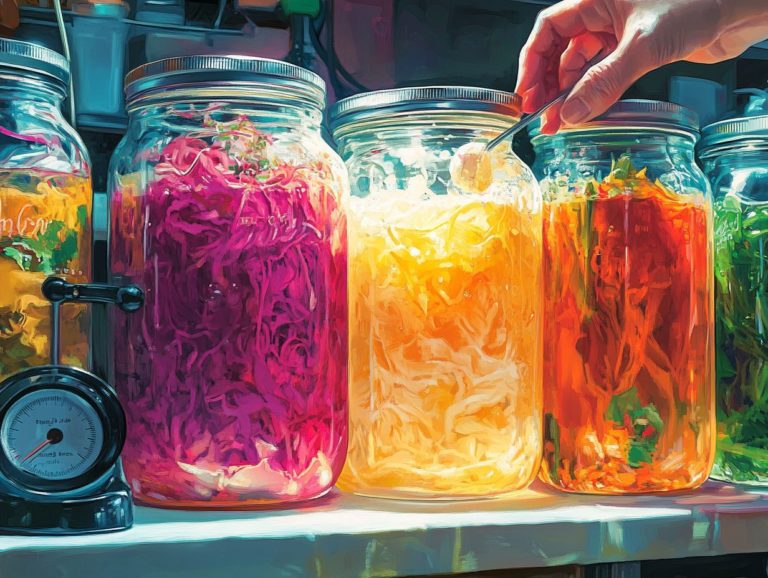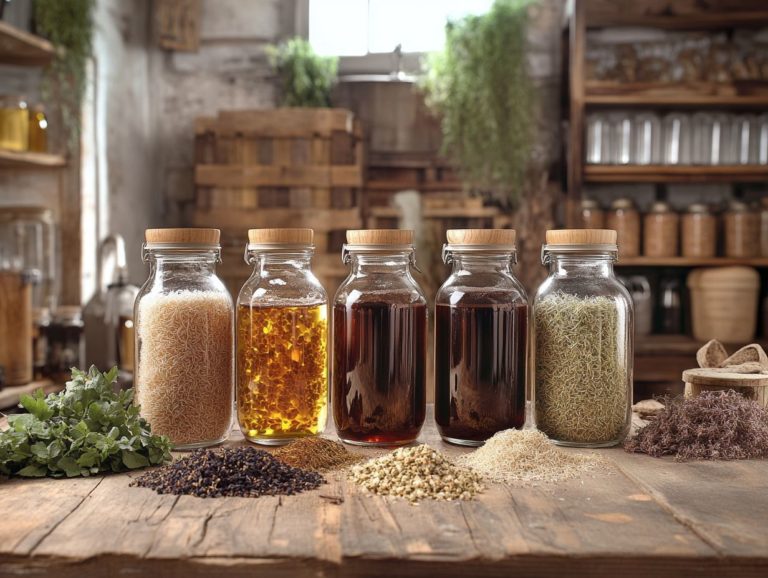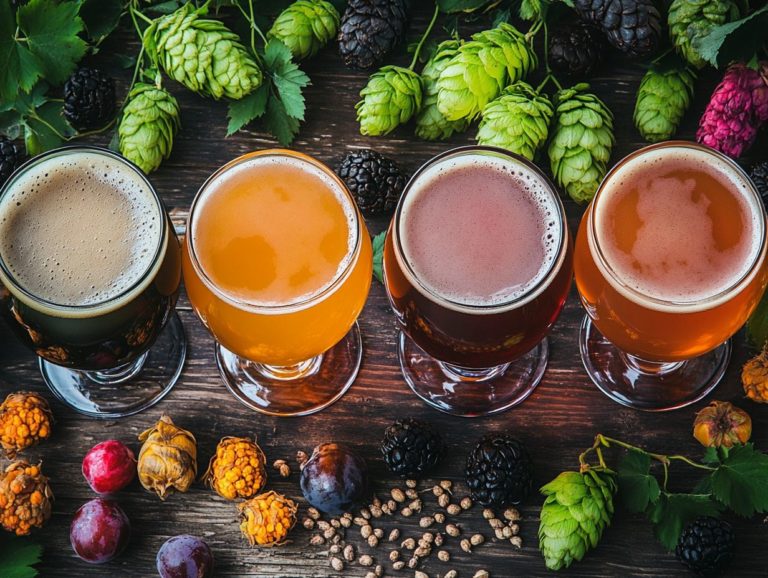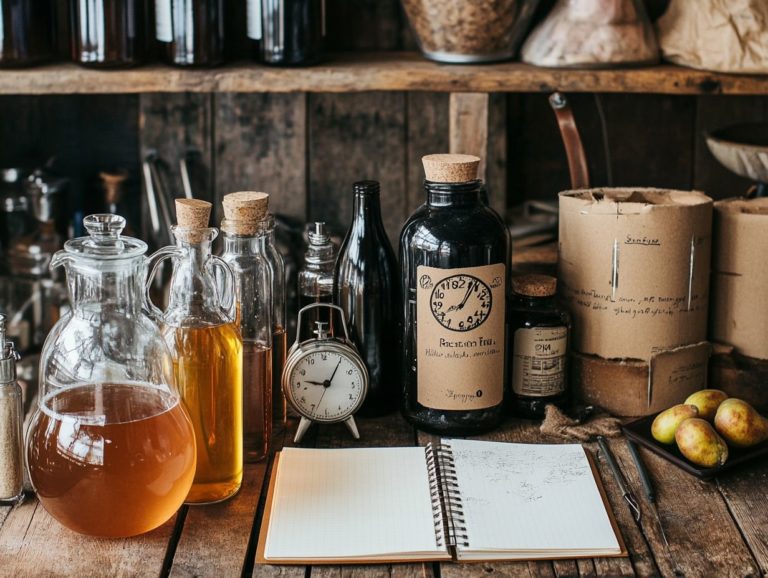How Fermentation Affects Beer Aroma
Fermentation is an art that transforms simple ingredients into complex and flavorful beers. It goes beyond just the alcohol; it encompasses the enticing aroma as well.
From fruity esters to spicy phenols, the scents generated during fermentation can elevate a beer’s profile to remarkable heights. This exploration delves into the various types of fermentation, the vital roles played by yeast and hops, and the impact of factors such as temperature and time on beer aroma and flavors.
Whether you re a seasoned brewer or simply a curious enthusiast in homebrewing, you ll uncover how to manipulate and enhance beer aromas, guiding you in the pursuit of your perfect brew.
Contents
- Key Takeaways:
- What Is Fermentation?
- How Does Fermentation Affect Beer Aroma?
- What Are The Key Factors That Influence Beer Aroma During Fermentation?
- How Do Different Yeast Strains Affect Beer Aroma During Fermentation?
- What Role Do Hops Play In Beer Aroma During Fermentation?
- What Are The Common Aromas Produced During Fermentation?
- How Can Brewers Control and Manipulate Beer Aroma During Fermentation?
- What Are The Effects Of Temperature And Time On Beer Aroma During Fermentation?
- How Can Homebrewers Experiment With Beer Aroma During Fermentation?
- Frequently Asked Questions
- Can the temperature and length of fermentation affect the aroma of beer?
- Are there any other factors besides fermentation that can affect the aroma of beer?
- Can fermentation affect the overall quality of a beer’s aroma?
Key Takeaways:
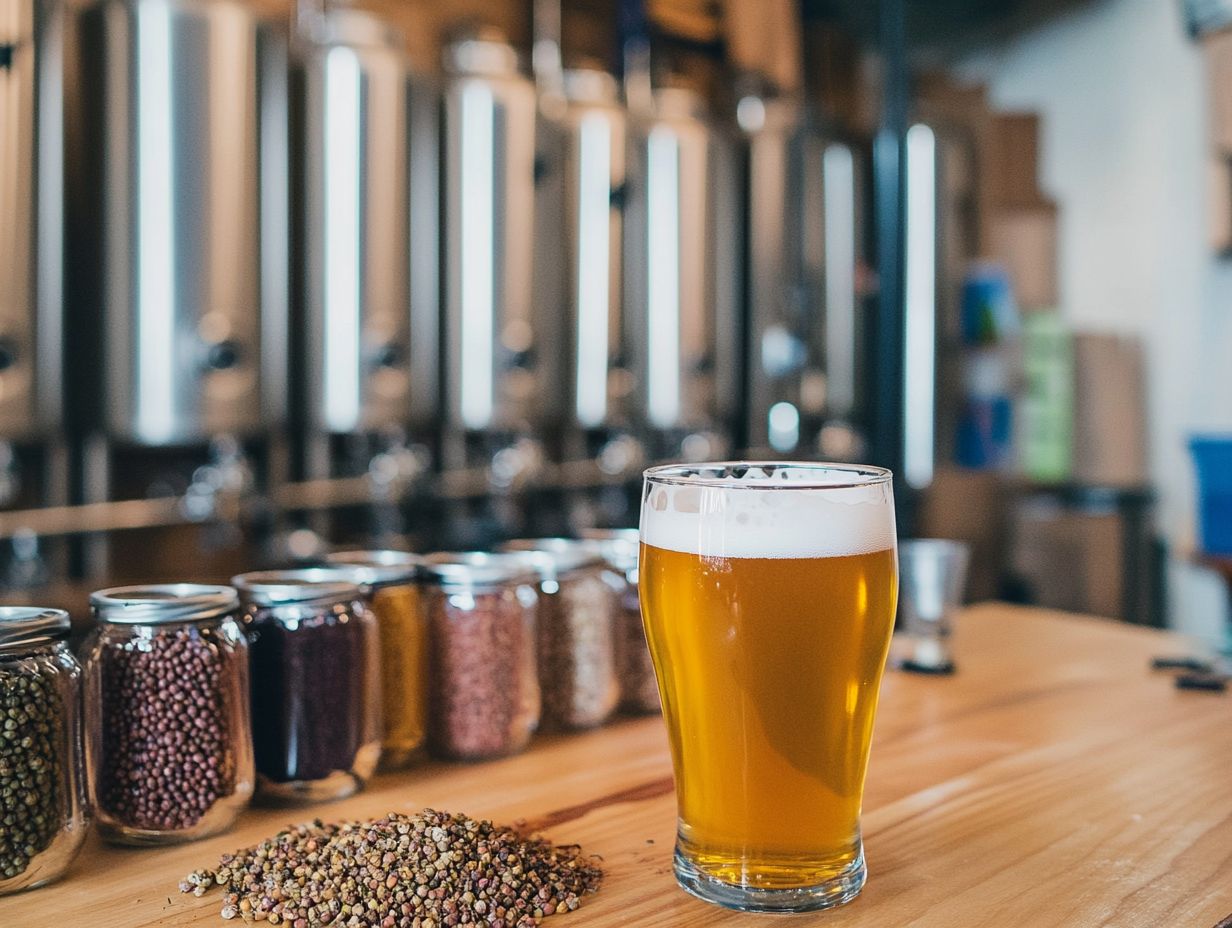
- Fermentation plays a crucial role in the production of beer aroma. Factors such as yeast strain, hops, and grain/sugar composition all influence the final result. Techniques like temperature control and yeast selection are essential in managing fermentation flavors.
- Esters, phenols, and sulfur compounds are common aromas produced during fermentation. Their presence and intensity depend on various factors.
- Brewers can manipulate and enhance beer aroma during fermentation through techniques like dry hopping, temperature control, and using different yeast strains.
What Is Fermentation?
Fermentation is a fascinating natural process used in brewing, where yeast, particularly Saccharomyces cerevisiae, transforms sugars derived from malted barley into alcohol and carbon dioxide. Alongside this transformation, it generates an array of flavors and aromas that are crucial for crafting various beer styles. This process involves fermentation tanks and vessels to control the conditions effectively.
This intricate process is instrumental in developing esters and phenolic compounds. These contribute to the distinctive character of the final product. Good esters and phenols add desirable fruity and spicy notes, while bad esters can result in off-flavors.
For brewers like you, mastering fermentation management techniques is essential to elevate your brewing outcomes and achieve the flavors you envision. This includes understanding yeast growth, specific gravity, and managing fermentation byproducts like diacetyl and acetaldehyde.
What Are The Different Types Of Fermentation?
In brewing, you encounter two primary types of fermentation: top fermentation and bottom fermentation. Top fermentation is commonly associated with ales, while bottom fermentation is typically reserved for lagers. Each type harnesses specific yeast strains that thrive at different fermentation temperatures, creating distinctive styles and flavor profiles that define the beers you enjoy.
Top fermentation, as exemplified by Hefeweizens, involves yeast that rises to the surface during the brewing process. This allows for the development of fruity and spicy notes due to those higher temperatures. Conversely, bottom fermentation, seen in British yeast ales, utilizes yeast that settles at the bottom, resulting in cleaner, crisper profiles that highlight malt and hop characteristics.
Your choice of yeast strain and fermentation environment doesn t just impact flavor; it also influences the aroma and mouthfeel of the beer. This knowledge enables you to appreciate the craft behind unique and memorable brews. Don’t miss out on experimenting with secondary fermentation it’s a fantastic way to refine your brew!
How Does Fermentation Affect Beer Aroma?
Fermentation plays a crucial role in shaping the aroma of beer by generating a diverse array of compounds, including esters and phenols. These enhance the overall scent and flavor profile of your beverage.
Esters introduce delightful fruity aromas that evoke the essence of bananas or apples, while phenolic compounds may add intriguing spicy or clove-like notes. The specific yeast strains and fermentation conditions you choose during the brewing process will ultimately influence the unique character of your beer.
In conclusion, fermentation is vital in beer brewing, significantly impacting aroma and flavor. Exploring different techniques can lead to exciting discoveries in your brewing journey.
What Are The Key Factors That Influence Beer Aroma During Fermentation?
Several key factors influence the aroma of your beer during fermentation, including fermentation temperature, yeast selection, and the management of fermentation byproducts. The temperature at which you ferment can significantly affect yeast activity and the production of esters and phenolic compounds.
Choosing the right yeast strain is equally important, as it shapes the specific flavour and aroma profile of your brew. For example, fermenting at warmer temperatures often encourages the development of fruity esters, allowing flavors reminiscent of bananas or apples to emerge.
Different yeast strains bring their own unique profiles to the table. Kveik yeast, for instance, thrives in warmer climates and produces vibrant tropical aromas, while traditional British yeasts lean toward milder, more subtle esters with earthy notes.
Managing byproducts like diacetyl and sulfur compounds is crucial, as excessive amounts can compromise the intended aroma of your beer. By understanding these dynamics, you can masterfully craft the sensory experience you desire in each batch.
How Do Different Yeast Strains Affect Beer Aroma During Fermentation?
Different yeast strains are important in shaping the aroma of your beer during fermentation, as each strain crafts its own unique flavours and varying levels of esters. Take Hefeweizens, for example; they typically utilize German Wheat yeast, renowned for its delightful clove and banana aromas.
British yeast and Kveik yeast each have unique aromatic profiles that enhance the diversity of beer styles available. On the other hand, Kveik yeast is celebrated for its remarkable ability to produce fruity esters, even at elevated fermentation temperatures.
Then there are the newer strains, like San Diego Super Yeast, which have made quite an impression in the brewing community due to their exceptional efficiency and the clean, unique aromas they bring to the table. This strain can rapidly ferment a variety of styles while leaving behind pleasant undertones that beautifully complement hoppy profiles, enhancing your overall sensory experience.
By understanding how these diverse yeast strains interact with malt and hops, you can elevate the flavours in your brews and make informed decisions that lead to exquisite craft creations, appealing to both traditional and contemporary tastes.
What Role Do Hops Play In Beer Aroma During Fermentation?

Hops are essential to the brewing process, playing an important role in shaping the aroma of your beer both during and after fermentation. They bring a remarkable array of scents, ranging from citrusy and floral to earthy and spicy. This vibrant palette of aromas beautifully complements or contrasts with the esters and phenolic compounds generated by the yeast, elevating the overall sensory experience of the beer.
The timing of your hop additions is crucial in determining how these aromatic profiles unfold. For example, adding hops early in the boil primarily contributes to the beer’s bitterness. However, if you hold off on those additions until the end of the boil or even during fermentation, the volatile oils in the hops begin to shine, resulting in a rich bouquet of aromas.
Choosing hop varieties like Citra and Mosaic can infuse your brew with bright tropical notes, while traditional varieties like Saaz and Hallertau can introduce delicate herbal qualities. Furthermore, the interplay between your selected hop varieties and the yeast strain you use is significant. Certain yeast profiles can amplify specific hop aromas, crafting a more intricate flavour profile that resonates with craft beer aficionados.
What Are The Common Aromas Produced During Fermentation?
During fermentation, a variety of aromas emerge, mainly categorized as esters and phenols. Esters, frequently linked to delightful fruity notes like ethyl butyrate, enhance the sweetness and complexity of your beers.
However, if not managed well, butyric acid can create unwanted flavours. On the other hand, phenols can introduce intriguing spiciness and earthy characteristics, significantly shaping the aromatic profile of the brew you re enjoying.
Experimenting with different yeast strains and hop varieties in your brewing process can lead to exciting new flavours.
What Are The Esters And Phenols That Contribute To Beer Aroma?
Esters and phenols play a crucial role in shaping the aroma of beer during fermentation. If you re aiming for a memorable brew, you ll want to pay close attention to these compounds. Common esters like ethyl butyrate are known for their delightful fruity aromas, while phenolic compounds such as 4-ethyl-phenol and 4-vinyl guaiacol bring in spicy and smoky notes, respectively. This interplay creates the complex aromatic profile that every brewer strives to achieve.
These aromatic compounds emerge under specific fermentation conditions, including your choice of yeast strain and fermentation temperature. Both of these factors significantly influence their production levels. For example, esters like isoamyl acetate are often linked to banana-like aromas, making them a staple in Hefeweizens and other wheat beers. Conversely, Belgian-style ales can showcase a spectrum of phenolic characteristics, particularly that clove-like spiciness that certain yeast strains deliver. Even within the category of esters, distinguishing between good esters and bad esters is key to achieving the desired profile.
By grasping the intricate balance of these compounds, you can craft beers that tantalize the palate and provide a truly multi-dimensional sensory experience.
What Are The Sulfur Compounds That Affect Beer Aroma?
Sulfur compounds play a significant role in shaping the aroma of your beer, often bringing both delightful and off-putting characteristics to the table. During fermentation, compounds like hydrogen sulfide can create aromas reminiscent of rotten eggs, while others can elevate the complexity of your beer s aroma profile. Effectively managing these compounds is vital to avoid ruining your brew!
Beyond hydrogen sulfide, yeast can produce a variety of sulfur compounds such as dimethyl sulfide (DMS) and thiols, which introduce fruity or herbal notes that many brewers find appealing. The real challenge for you lies in achieving the perfect balance of these compounds to create an optimal aroma and the right ester profile.
To manage them effectively, consider implementing a few strategic approaches:
- Choose specific yeast strains known for their lower sulfur production, such as British yeast or Kveik yeast.
- Optimize fermentation temperatures for better results, taking care to avoid both good esters and bad esters.
- Ensure proper aeration during the initial stages of fermentation to support yeast growth.
By taking these steps, you can minimize the presence of undesirable sulfur while enhancing the pleasant aromas that define a well-crafted beer.
How Do Different Grains And Sugars Affect Beer Aroma During Fermentation?
The grains and sugars you choose play an important role in shaping the aroma of your beer during fermentation. These essential ingredients provide the fermentable sugars that yeast will transform into alcohol and carbon dioxide. Different malt varieties contribute unique flavors, while the types of sugars you incorporate can significantly influence the fermentation process and the aromatic profile of your brew.
By opting for specific roasted malts, you have the power to introduce rich and complex aromas that can range from chocolate and coffee to caramel and nuttiness. Each of these enhances your beer’s character. When you add priming sugar, it not only helps achieve that perfect carbonation level but also introduces subtle notes of sweetness and amplifies the fruity esters produced by the yeast. Feel free to experiment with phenolic compounds and unleash a world of spicy or smoky notes!
These delicate nuances highlight the remarkable complexity of the brewing process. Even small adjustments in grain selection or the type of sugar can create a vastly different sensory experience, captivating both seasoned connoisseurs and casual drinkers alike.
How Can Brewers Control and Manipulate Beer Aroma During Fermentation?
As a brewer, you wield significant control over the aroma of your beer during fermentation by employing specific techniques and management practices that shape yeast behavior and the creation of aromatic compounds.
By thoughtfully selecting yeast strains, regulating fermentation temperatures, and expertly managing fermentation byproducts, you can craft a beer that boasts an aromatic profile perfectly aligned with your creative vision.
Techniques to Enhance Beer Aroma During Fermentation
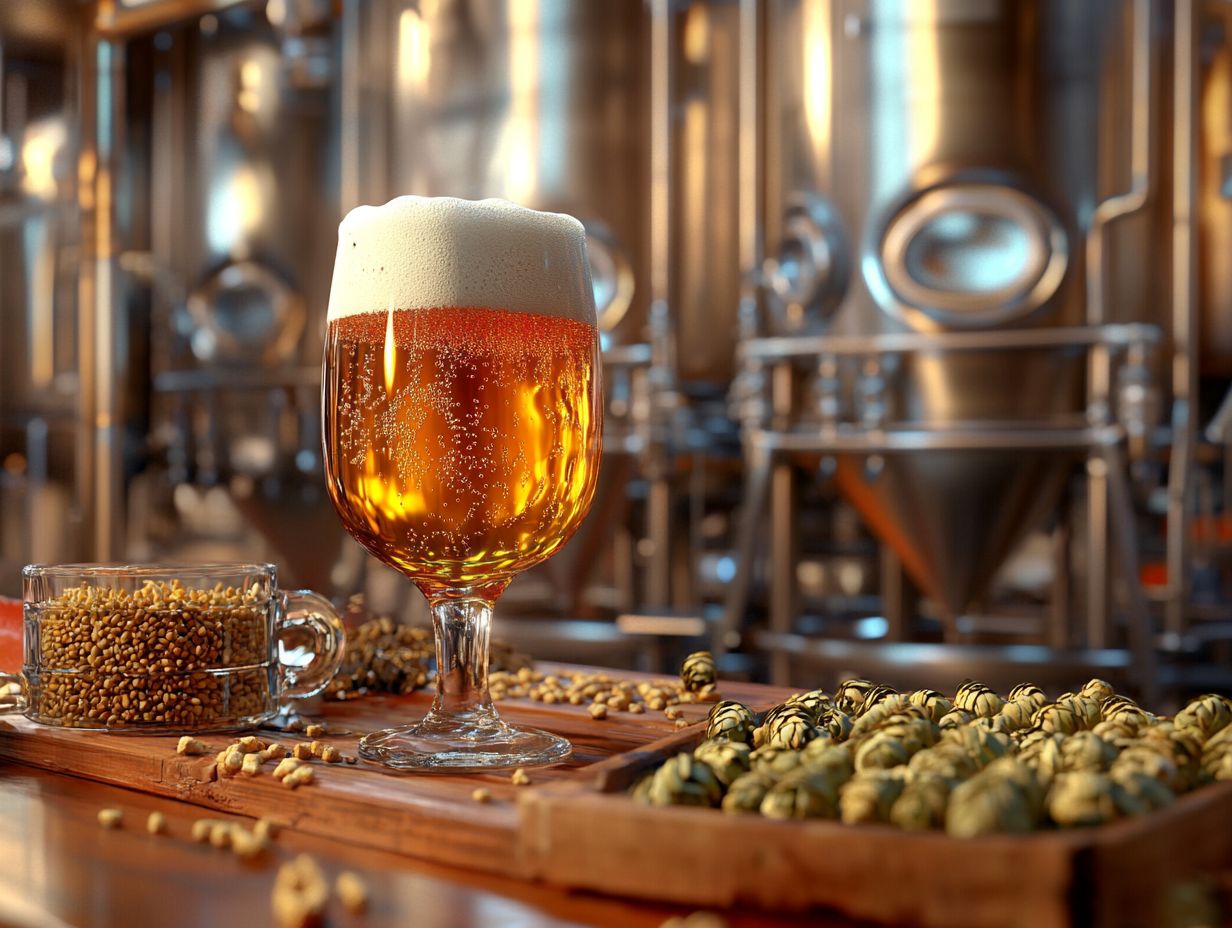
As a brewer, you have a wealth of techniques at your fingertips to enhance or transform beer aroma during fermentation. Adjusting fermentation temperatures, blending different yeast strains, and employing methods like dry hopping or late hopping can all contribute aromatic hops to your beer.
Varying fermentation times can significantly influence the development of esters and phenolic compounds aromatic compounds that give fruity and spicy flavors, respectively adding depth to the overall profile.
Consider how manipulating the mash temperature can shape your brew. Higher temperatures often yield a fuller body, which beautifully complements certain aromatic compounds. For example, you might choose to mash at around 156 F to encourage the production of sweet, malty aromas that elevate your beer’s character.
Using yeast nutrients during this stage can further optimize the fermentation process. Another powerful approach is selecting specific fermentation yeasts that impart distinct characteristics. Take Belgian yeasts, for instance; they are celebrated for generating clove or banana notes, adding layers of complexity to your final product.
Alternatively, you could use German Wheat yeast for Hefeweizens, known for their fruity and spicy profiles. Ultimately, these techniques enable you to create unique beers, drawing out a diverse range of aromas that truly resonate with consumers.
Best Practices for Consistent Beer Aroma
Maintaining a consistent beer aroma during fermentation necessitates a commitment to best practices that span the entire brewing process. Start your brewing journey with precise temperature control, diligent yeast management, and impeccable sanitation techniques. By adhering to these practices, you can ensure that the aromatic profile of your beer remains stable across batches.
Achieving this level of consistency relies not only on selecting high-quality ingredients but also on rigorously monitoring yeast health. Act quickly to monitor your yeast health; it s vital for a perfect brew every time. Regularly checking vital signs such as cell count and viability is essential to prevent any off-aromas that could compromise your brew.
Opting for the right fermentation vessels, like conical fermenters or fermentation tanks, facilitates optimal yeast harvesting and minimizes undesirable byproducts. Environmental factors must not be overlooked; controlling variables such as humidity and air quality significantly mitigates risks associated with contamination.
Utilizing proper fermentation management techniques will aid in maintaining a consistent and desirable aroma. Ultimately, a meticulous approach to fermentation management will lead to beers that consistently captivate with their aromatic allure.
In conclusion, mastering the art of beer aroma during fermentation is essential for brewers. By experimenting with various techniques and adhering to best practices, you can create exceptional brews that continually delight your consumers.
What Are The Effects Of Temperature And Time On Beer Aroma During Fermentation?
Temperature and time are critical factors that significantly influence the aroma of beer during fermentation. They directly affect yeast activity and the production of aromatic compounds. Selecting the right yeast strains and managing fermentation byproducts can make a big difference.
When you ferment at higher temperatures, you can encourage the development of fruity esters, which enhance the complexity of your brew. However, if fermentation is prolonged, it may result in undesirable flavors such as diacetyl or acetaldehyde creeping in. This underscores the importance of finding the perfect balance in your brewing process and using precise control measures.
How Do Different Fermentation Temperatures And Durations Impact Beer Aroma?
Different fermentation temperatures and durations can yield a fascinating array of aromas in your beer. Warmer temperatures often boost the production of esters, which are compounds that contribute fruity scents, while cooler conditions tend to result in a cleaner, crisper profile.
If you extend the fermentation time, you might discover specific flavors and aromas developing, like diacetyl or acetaldehyde, which you ll want to manage with care. Yeast selection also plays a crucial role in this process.
For instance, when you ferment at those higher temperatures think beyond 75 F (24 C) esters like isoamyl acetate can bring forth fruity aromas that evoke memories of bananas or apples. This makes it a perfect fit for styles like Hefeweizen or Belgian ales.
On the flip side, if you opt for lower temperatures around 60 F (15 C), you typically end up with lagers that are refreshingly crisp, with a subtly malty profile that doesn t overwhelm the senses. Utilizing proper fermentation science and monitoring specific gravity can also help you achieve desired results.
Allowing certain ales to ferment for a longer time enhances complex flavors and creates deeper bouquets. Finding the right balance between temperature control and fermentation duration is essential for achieving that perfect aromatic profile in your brews. Some brewers, like Kara Taylor from White Labs, emphasize the importance of these factors in crafting high-quality beer.
What Are The Risks Of Improper Fermentation Temperature And Duration On Beer Aroma?
Improper fermentation temperatures and durations can dramatically alter your beer’s aroma, leading to unexpected off-flavors like diacetyl, which has a distinctly buttery aroma, and acetaldehyde, often described as reminiscent of green apples. These unwelcome characteristics can compromise the intended flavor profile and overall quality of your brew. This highlights the critical importance of precise fermentation management.
Your yeast’s health is paramount in the fermentation process. Stressed yeast can generate elevated levels of unwanted esters and phenols, contributing clove or banana flavors that clash with your desired profile. If you don t monitor fermentation closely, you might encounter issues like incomplete fermentation, resulting in a sweetness that overshadows the intended hop bitterness. Utilizing yeast nutrients and proper yeast selection can help mitigate these issues.
Inadequate sanitation during fermentation can lead to contamination from wild yeast or bacteria, further complicating the flavor landscape and detracting from the quality of your final product. Grasping these risks is essential for any brewer who aspires to craft a consistent and enjoyable beer. Proper fermentation management and the use of appropriate fermentation vessels are critical.
Experimenting with fermentation temperature and time can lead to amazing aromas in your brews. Balance is key!
How Can Homebrewers Experiment With Beer Aroma During Fermentation?
As a homebrewer, you have a remarkable opportunity to experiment with beer aroma during fermentation by adjusting a variety of factors, including yeast selection, fermentation temperature, and ingredient combinations. Understanding the underlying fermentation science will be beneficial.
This hands-on approach enables you to craft personalized flavor profiles, allowing you to dive deep into the fascinating complexities of fermentation science right in your own brewing setup. Experimenting with different yeast strains, such as San Diego Super Yeast, can yield unique results.
What Are Some DIY Techniques For Altering Beer Aroma During Fermentation?
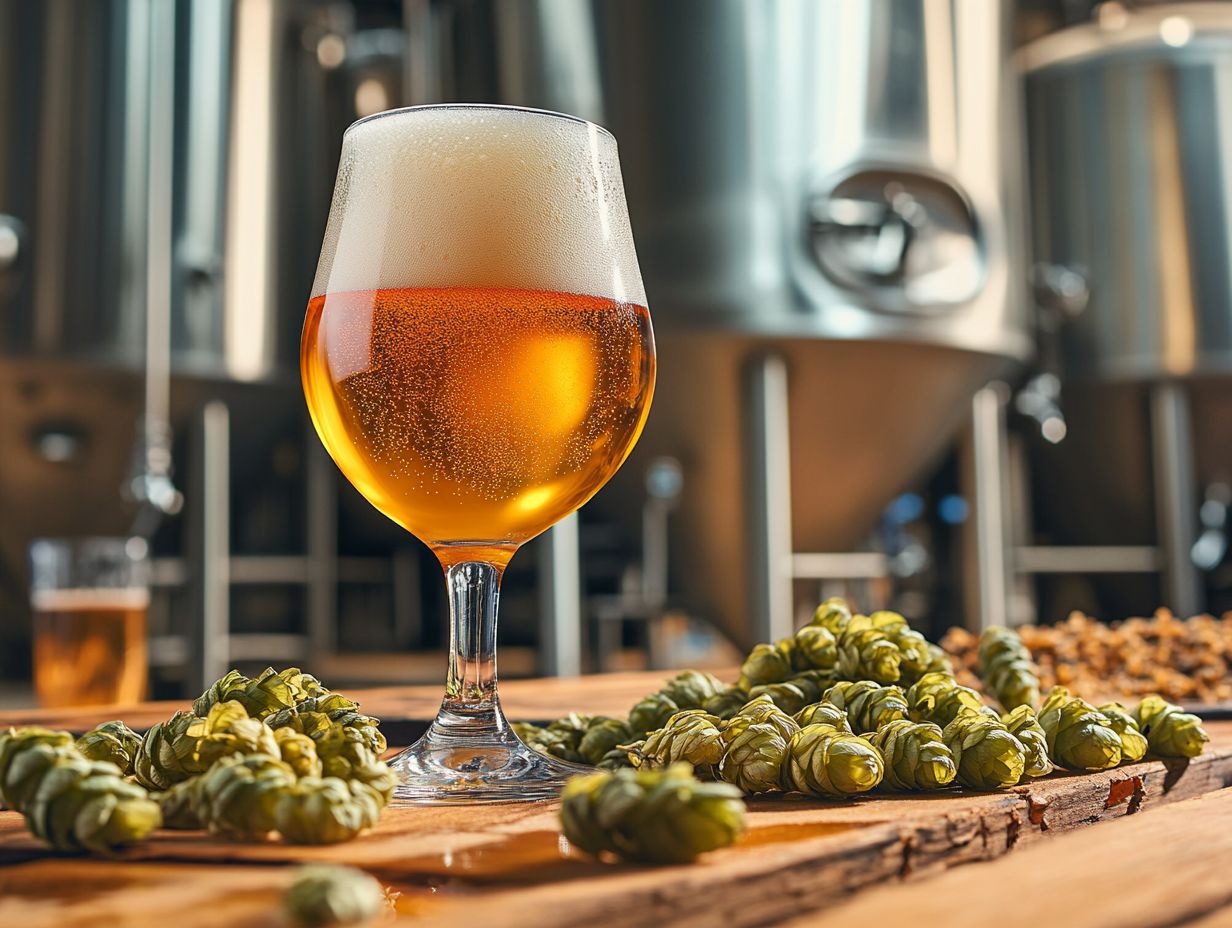
You can employ several DIY techniques to enhance the aroma of your beer during fermentation. Consider adding fruits or spices at specific moments in the brewing process or experimenting with dry hopping. These methods enable you to customize your brews and uncover new aromatic dimensions in your creations.
For example, incorporating citrus peels or coriander during the boil can infuse refreshing citrus notes into your beer. On the other hand, adding chocolate or coffee beans during the secondary fermentation stage can yield rich, indulgent aromas. Measurements to determine the ideal time for these additions can help you achieve the best results.
By using different yeast strains, each known for unique ester and phenol profiles, you can create a wide array of fragrant qualities that enhance the overall complexity of your final product. For those who are into Belgian-style beers, Saccharomyces cerevisiae strains are an excellent choice for adding depth and complexity.
With careful timing for adding these ingredients and a solid understanding of their fermentation characteristics, you’ll be amazed at how you can transform your beer, turning every batch into a delightful adventure in flavor exploration.
How Can Homebrewers Learn To Recognize And Identify Different Aromas During Fermentation?
Recognizing and identifying the diverse aromas produced during fermentation is crucial for you as a homebrewer striving to refine your skills and elevate your brews. By employing sensory evaluation techniques like smelling and tasting various beer samples you can cultivate a deeper understanding of how different yeast strains and fermentation conditions impact aroma.
To enhance your sensory evaluation skills further, consider joining tasting groups where you can exchange insights and experiences with fellow enthusiasts. Keeping meticulous notes on each brew will serve as a valuable reference, helping you recognize distinct characteristics and patterns that emerge over time. Utilizing resources such as aroma wheels can assist you in pinpointing specific scents, allowing you to classify your observations with precision.
Engaging with training modules from online platforms or attending workshops will provide structured methods for mastery. This commitment not only elevates the quality of your homebrews but also broadens your palate, making your brewing journey all the more rewarding.
Consider joining local brewing clubs or attending beer-tasting events for practical experience and community interaction.
Frequently Asked Questions
Here are some frequently asked questions to deepen your understanding of beer fermentation and aroma.
What is fermentation and how does it affect the aroma of beer?
Fermentation is the process by which yeast converts sugar into alcohol and carbon dioxide. This process also produces compounds that contribute to the aroma of beer, such as esters, phenols, and other flavor compounds.
How does the type of yeast used in fermentation impact the aroma of beer?
The type of yeast used in fermentation plays a significant role in the aroma of beer. Different strains of yeast produce different compounds, resulting in varying levels of fruity, spicy, or earthy aromas in the finished product.
Can the temperature and length of fermentation affect the aroma of beer?
Absolutely! The temperature during fermentation can dramatically enhance the aroma of your beer. Higher temperatures can lead to more intense and complex aromas, while lower temperatures can result in a cleaner and more subtle aroma. Moreover, the length of fermentation plays a crucial role in developing these aromas. A longer fermentation period allows more time for yeast tiny organisms responsible for fermentation to produce flavor compounds, resulting in a more complex and pronounced aroma.
Are there any other factors besides fermentation that can affect the aroma of beer?
Yes, several other factors can influence the aroma of beer. The type of malt and hops used, the water source, and the overall brewing process can either enhance or mask the aromas produced during fermentation. These elements are essential in crafting the final product you enjoy.
Can fermentation affect the overall quality of a beer’s aroma?
Absolutely! The fermentation process plays a crucial role in creating the unique and desirable aromas in beer. A well-executed fermentation can result in a balanced and harmonious aroma, while a poorly executed one can lead to off-flavors and undesirable aromas. To truly appreciate the art of brewing, consider experimenting with different fermentation techniques at home. You’ll discover a world of flavors waiting to be explored!

